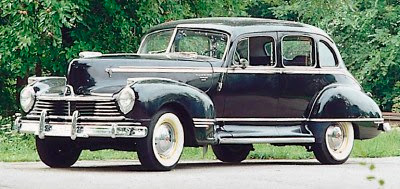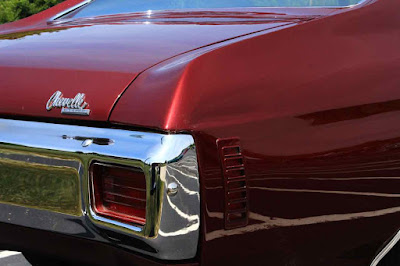 The 1935 Cadillac four-door sedan. Note the rear luggage accessory that could be attached for longer trips. It soon became obsolete.
The 1935 Cadillac four-door sedan. Note the rear luggage accessory that could be attached for longer trips. It soon became obsolete.
The 1935 Chrylser Airflow 2-door signaled change.
 A 1935 Lincoln Model K roadster. Note the rear quarter panel and its storage area. White sidewall tires and solid, not wire, wheels became part of the standard running gear. Lincoln's stunning Zephyr and Continental models were still on the drawing boards.
A 1935 Lincoln Model K roadster. Note the rear quarter panel and its storage area. White sidewall tires and solid, not wire, wheels became part of the standard running gear. Lincoln's stunning Zephyr and Continental models were still on the drawing boards.
The Packard 4-door Sedan. This maker produced some of the most luxurious and flat-out elegant vehicles of the late 1930s and early Forties, especially the Victoria and Darren-designed phaetons and convertibles.
The year of 1935 forecast the future of automobile design until World War II consumed the nation's manufacturing. The industry was still wobbling through the Great Depression and sales were modest, even bleak at times, for these luxury models shown.
Innovations such as hydraulic and vacuum-assisted braking began to appear. Automatic transmissions were only dreamt of or experimental. There were, however, syncromesh transmissions offered by the various marques and overdrive could be ordered for such higher-end cars pictured.
The Chrysler Airflow offered a glimpse of things to come. None other than Orville Wright suggested Chrysler build a wind tunnel to both study and market streamlining. The public found its flowing lines a bit radical for the times, but eventually the sculpting of hoods, fenders, and trunk areas became accepted. Even the lower-priced Fords, Chevrolets, Plymouths, and Dodges took on an aura similar to the more expensive members of the families and sported hood ornaments which became collectible. Studebaker, Hudson, Nash, DeSoto, Buick, Olds did likewise and were well regarded.
Fender wells for the pair of spares, unfortunately in the view of some, began to disappear and spares were assigned to the rear deck or mounted in the trunk. Wells were subject to rust as were the bullet-shaped headlights. Nonetheless, the pre-war models such as these pictured symbolized a time of automobile design and elegance never to be seen again.










































